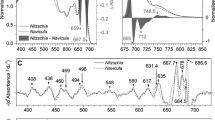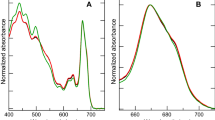Abstract
When grown at intermittent light regime, diatom alga Phaeodactylum tricornutum is able to form photoprotective non-photochemical chlorophyll fluorescence quenching (NPQ) three to five times larger than that observed in the higher plants. This quenching is sustained in the dark for 5 to 10 min, reverses completely within approximately 1 h and seems to be very tightly related to the presence of the zeaxanthin analogue, diatoxanthin. Addition of the uncoupler NH4Cl before illumination can completely abolish formation of NPQ, revealing the ΔpH-dependency of the xanthophyll cycle activity. Once established, NPQ can also be almost completely reversed by the uncoupler. However, the higher NPQ is formed the more time is required for its reversal. At the point when the fluorescence was approximately 90% recovered the level of illumination-induced diatoxanthin was found to be only partially reduced. This indicates that the proton gradient is a key triggering factor of NPQ. It was also noticed that NPQ in Phaeodactylum cells was absent even when majority of reaction centers were closed and the plastoquinone pool was significantly reduced. The absence of NPQ at these conditions could be due to very low levels of ΔpH. It is likely that in diatoms alternative sources of protons such as the PS I cyclic electron transfer and/or chlororespiration are important in generating the proton gradient sufficient to trigger NPQ. Absorption changes associated with the xanthophyll cycle activity were found to be larger than those for higher plants. The position of the positive maximum in the difference spectrum illuminated-minus-dark was 512–514 nm in comparison to the 505–508 nm for leaves. The 535 nm band associated with NPQ in plants is absent in Phaeodactylum. An uncoupler-sensitive absorption change at 522 nm was discovered. Kinetics of NPQ showed linear correlation with the 522 nm absorption change.
Similar content being viewed by others
References
Arsalane W, Rousseau B and Duval JC (1994) Influence of the pool size of the xanthophyll cycle on the effects of light stress in a diatom-competition between photoprotection and photoinhibition. Photochem Photobiol 60: 237-243
Aspinall-O'Dea M, Wentworth M, Pascal A, Robert B, Ruban AV and Horton P (2002) The PsbS subunit of Photosystem II binds zeaxanthin and activates it for nonphotochemical fluorescence quenching. Proc Natl Acad Sci USA 99: 16331-16335
Barber J (1995) Molecular basis of the vulnerability of Photosystem-II to damage by light. Aust J Plant Physiol 22: 201-208
Caron L, Berkaloff C, Duval J-C and Jupin H (1987) Chlorophyll fluorescence transients from the diatom Phaeodactylum tricornutum: relative rates of cyclic phosphorylation and chlororespiration. Photosynth Res 11: 131-139
Casper-Lindley C and Bjorkman O (1998) Fluorescence quenching in four unicellular algae with different lightharvesting and xanthophyll cycle pigments. Photosynth Res 56: 277-289
Davison PA, Hunter CN and Horton P (2002) Overexpression of beta-carotene hydroxylase enhances stress tolerance in Arabidopsis. Nature 418: 203-206
Demmig-Adams B (1990) Carotenoids and photoprotection in plants-a role for the xanthophyll zeaxanthin. Biochim Biophys Acta 1020: 1-24
Demmig-Adams B and Adams III WW (1992) Photoprotection and other responses of plant to high light stress. Annu Rev Plant Physiol Plant Mol Biol 43: 599-626
Field CB, Behrenfeld MJ, Randerson JT and Falkowski P (1998) Primary production of the biosphere: integrating terrestrial and oceaniccomponents. Science 281: 237-240
Frank HA, Cua A, Chinwat V, Young A, Gosztola D and Wasielewski MR (1994) Photophysics of the carotenoids associated with the xanthophyll cycle in photosynthesis. Photosynth Res 41: 389-395
Gilmore AM (1997) Mechanistic aspects of xanthophyll cycledependent phtoprotection in higher plant chloroplasts and leaves. Physiol Planta 99: 19-209
Hager A and Stransky H (1970) Das Carotinoidmuster und die Verbreitung des lichtinduzieren Xanthophyllcyclus in verschiedenen Algenklassen. V. Einzelne Vertreter der Cryptophyceae, Euglenophyceae, Bacillariophyceae, Chrysophyceae and Phaeophyceae. Arch Mikrobiol 73: 77-89
Horton P and Ruban AV (1992) Regulation of Photosystem II. Photosynth Res 34: 375-385
Horton P, Ruban AV and Walters RG (1996) Regulation of light harvesting in green plants. Ann Rev Plant Physiol Plant Mol Biol 47: 655-684
Horton P, Ruban AV and Wentworth M (2000) Allosteric regulation of the light-harvesting system of Photosystem II. Phil Trans R Soc London Ser B 355: 1361-1370
Jakob T, Goss R and Wilhelm C (1999) Activation of diadinoxanthin de-epoxidase due to a chlororespiratory proton gradient in the dark in the diatom Phaeodactylum tricornutum. Plant Biol 1: 76-82
Krause GH and Weis E (1991) Chlorophyll fluorescence and photosynthesis: the basics. Annu Rev Plant Physiol Plant Mol Biol 42: 313-349
Lavaud J, Rousseau B, van Gorkom HJ and Etienne A-L (2002a) Influence of the diadinoxanthin pool size on the photoprotection in marine planktonic diatom Phaeodactylum tricornutum. Plant Physiol 129: 1398-1406
Lavaud J, Rousseau B and Etienne A-L (2002b) In diatoms, a transthylakoid proton gradient alone is not sufficient to induce a non-photochemical fluorescence quenching. FEBS Lett 523: 163-166
Lavaud J, Rousseau B and Etienne A-L (2002c) Photosystem II electron transfer cycle and chlororespiration in planktonic diatoms. Photosynth Res 74: 51-59
Lavaud J, Rousseau B and Etienne A-L (2003) Enrichment of the light-harvesting complex in diadinoxanthin and implications for the non-photochemical fluorescence quenching in diatoms. Biochemistry 42: 5802-5808
Li XP, Bjorkman O, Shih C, Grossman AR, Rosenquist M, Jansson S and Niyogi K (2000) A pigment-binding protein essential for regulation of photosynthetic light havesting. Nature 403: 391-395
Li XP, Phippard A, Pasari J and Niyogi K (2002a) Structurefunction analysis of Photosystem II subunit S (PsbS) in vivo. Funct Plant Physiol 29: 1131-1139
Li XP, Muller-Moule P, Gilmore AM and Niyogi K (2002b) PsbS-dependent enhancement of feedback de-excitation protects Photosystem II from photoinhibition. Proc Natl Acad Sci USA 99: 15222-15227
Li XP, Gilmore AM and Niyogi KK (2002c) Molecular and global time-resolved analysis of a psbS gene dosage effect on pH-and xanthophyll cycle-dependent nonphotochemical quenching in Photosystem II. J Biol Chem 277: 33590-33597
Munekage Y, Hojo M, Meurer J, Endo T, Tasaka M and Shikanai T (2002) PGR5 is involved in cyclic electron flow around Photosystem I and is essential for photoprotection in Arabidopsis. Cell 110: 361-371
Niyogi K (1999) Photoprotection revisited: genetic and molecular approaches. Annu Rev Plant Physiol Plant Mol Biol 50: 333-359
Olaizola M, Laroche J, Kolber Z and Falkowski PG (1994) Nonphotochemical fluorescence quenching and the diadinoxanthin cycle in a marine diatom. Photosynth Res 41: 357-370
Osmond B (1981) Photorespiration and photoinhibition. Some implications for the energetics of photosynthesis. Biochim Biophys Acta 639: 77-98
Owens TG, Shreve AP and Albrecht AC (1992) Dynamics and mechanism of singlet energy transfer between carotenoids and chlorophylls: light harvesting and nonphotochemical fluorescence quenching. In: Murata N (ed) Research in Photosynthesis, Vol 4, pp 179-186. Kluwer Academic Publishers, Dordrecht, The Netherlands
Rees D, Young A, Noctor G, Britton G and Horton P (1989) Enhancement of the DpH-dependent dissipation of excitation energy in spinach chloroplasts by light-activation: correlation with the synthesis of zeaxanthin. FEBS Lett 256: 85-90
Ruban AV and Horton P (1995) An investigation of the sustained component of nonphotochemical quenching of chlorophyll fluorescence in isolated chloroplasts and leaves of spinach. Plant Physiol 108: 721-726
Ruban AV and Horton P (1999) The xanthophyll cycle modulates the kinetics of nonphotochemical energy dissipation in isolated light-harvesting complexes, intact chloroplasts and leaves of spinach. Plant Physiol 119: 531-542
Ruban AV, Rees D, Pascal A and Horton P (1992) Mechanism of DpH-dependent dissipation of absorbed excitation energy by photosynthetic membranes. II. The relationship between LHCII aggregation in vitro and qE in isolated thylakoids. Biochim Biophys Acta 1102: 39-44.
Ruban AV, Young AJ and Horton P (1993) Induction of nonphotochemical energy-dissipation and absorbency changes in leaves-evidence for changes in the state of light harvesting system of Photosystem II in vivo. Plant Physiol 102: 741-750
Ruban AV, Lee PJ, Wentworth M, Young AJ and Horton P (1999) Determination of the stoichiometry and strength of binding of xanthophylls to the Photosystem II light harvesting complexes. J Biol Chem 274: 10458-10465
Ruban AV, Pascal AA, Robert B and Horton P (2001) Configuration and dynamics of carotenoids in light-harvesting antennae of the thylakoid membrane. J Biol Chem 276: 24862-24870
Ruban AV, Pascal AA, Robert B and Horton P (2002a) Activation of zeaxanthin is an obligatory event in the regulation of photosynthetic light harvesting. J Biol Chem 277: 7785-7789
Ruban AV, Pascal AA, Lee PJ, Robert B and Horton P (2002b) Molecular Configuration of Xanthophyll Cycle Carotenoids in Photosystem II Antenna Complexes. J Biol Chem 277: 42937-42942
Smetacek VA (1999) Diatoms and the ocean carbon cycle. Protist 150: 25-32
Ting CS and Owens TG (1993) Photochemical and nonphotochemical fluorescence quenching processes in the diatom Phaeodactylum tricornutum. Plant Physiol 101: 1323-1330
Tréguer P, Nelson DM, van Bennekom AJ, De Master DJ, Leynaert A and Quéginer B (1995) The silica balance in the world ocean: a re-estimate. Science 269: 375-379
Verhoeven AS, Adams WW and Demmig-Adams B (1998) Two forms of sustained xanthophyll cycle-dependent energy dissipation in overwintering Euonymus kiautschovicus. Plant Cell Environ 21: 893-903
Wentworth M, Ruban AV and Horton P (2003) Thermodynamic investigation into the mechanism of the chlorophyll fluorescence quenching in isolated Photosystem II lightharvesting complexes. J Biol Chem 278: 21845-21850
Author information
Authors and Affiliations
Rights and permissions
About this article
Cite this article
Ruban, A., Lavaud, J., Rousseau, B. et al. The super-excess energy dissipation in diatom algae: comparative analysis with higher plants. Photosynthesis Research 82, 165–175 (2004). https://doi.org/10.1007/s11120-004-1456-1
Issue Date:
DOI: https://doi.org/10.1007/s11120-004-1456-1




